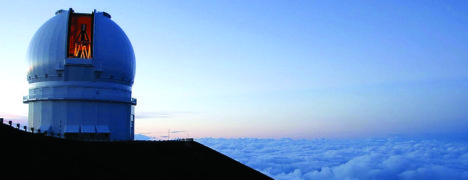Setting Sights on the Stars

Photo courtesy University of Hawaii
“Shoot for the stars” is advice often given to youth, but three Molokai High School students have earned the chance to take the phrase literally. They were awarded a once-in-a-lifetime opportunity to observe the stars through the one world’s best telescopes atop Maunakea.
Sunni Chow, Taye Mowat and Skylar Kuahuia are Molokai’s first Maunakea Scholars, a program run by the Canada-France-Hawaii Telescope (CFHT) that allows students observatory time based on research proposals they submitted. The ever-expanding program, started a few years ago, currently includes 10 Hawaii high schools.
“The program you’re in has never been done before and it’s unique worldwide… because we have the telescopes on Maunakea and no other kids in the world have that in their backyard,” said Doug Simons, CFHT executive director. “So this is a truly unique experiment in education, and we’re learning as we go along, and we’re convinced that for kids to participate in it can make a really big impact.”
The Canada-France-Hawaii telescope is, as its name implies, a joint facility of research organizations in Canada and France, and the University of Hawaii. Simons said the Maunakea Scholars program occurred to him as an idea in 2013 and took a couple years to become a reality.
“We crafted this program that kind of inverts this paradigm that I saw… that kids wanted to use the telescope but didn’t know how to access it,” he explained. “I wanted to flip it around so the observatories would reach out to students… to make it possible across the state to have access to these telescopes which are absolutely one of a kind worldwide.”

Photo by Catherine Cluett Pactol
A group of Molokai students under the guidance of MHS science teacher Emilio Macalalad worked on proposals and submitted them to the program. At a presentation at the high school last Friday, two of the projects were selected for the Maunakea Scholars program.
Chow and Mowat will take pictures of different open star clusters to determine out what stars are part of the cluster and how old they. Kuahuia will measure the physical properties of the star Sirius, such as brightness, color and rotational speed.
Simons said each of the awarded students will spend the day on Maunakea and get about an hour of telescope time in May. They’ll also have the mentorship assistance of JD Armstrong, Maui technology, education and outreach specialist for UH.
Simons said all proposals are evaluated by team of astronomers and scored on technical feasibility, scientific merit and creativity. About one third of the student proposals around the state are awarded. Mary Beth Laychak, CFHT outreach program manager, explained that feasibility much be considered for students to complete their projects in a relatively short period of time. For example, some Molokai students had proposed projects that are currently being studied by astronomers over the course of many years.
On May 18, all the students who participated in Maunakea Scholars will visit Maunakea, where they’ll get a behind the scenes look they’ll never forget, said Simons. It will include a cultural education program and a look at a couple of different telescopes atop the summit.
As the program has gained steam, Simons said other telescopes on Maunakea also participating now by allowing the Scholars observatory time, so students are paired with telescopes that best match their proposal.
“These are literally the most powerful telescopes in the world that are being made available to high school students,” said Simons.
Simons told Molokai students about his own journey to astronomy that began with a toy telescope he received from his parents in seventh grade. He read about Saturn and was determined to find it, spending hours at night looking at the stars.
“I felt like I was eavesdropping on another world… it was stunning to me,” he said. He finally found the planet, which was a game changer for him. “I started thinking of myself as an astronomer,” he laughed.
In 10th grade, he worked to buy parts to build his own telescope, and spend 300 hours grinding and polishing the mirror part that collects and reflects light. He went on to get his Bachelor’s degree in astronomy and attended University of Hawaii — his “last resort” school — for his graduate studies, a decision he said changed his life.
He said he now wants to help share astronomy opportunities with students in Hawaii, and now budding scientists at Molokai High will have that opportunity each year.
When Macalalad heard about Maunakea Scholars, he said he wanted to involve Molokai students to prove something.
“This would be a great opportunity to show what our kids can do,” he said. “When I go to other islands and talk to teachers, their perspective of Molokai High students is that they can’t. This shows that they can. They just need that chance.”
He had his students working on their proposals as their Science Fair projects and they continued to work on them through the end of last month to submit to the Maunakea Scholars program.
Simons encouraged students to find and follow their “flame,” adding that science is advancing at such a speed that the coming years will bring the unimaginable.
“There are so many things that are going on that you may think are unthinkable now, but are going to be reality in the near future,” he said.











Don't have a Molokai Dispatch ID?
Sign up is easy. Sign up now
You must login to post a comment.
Lost Password